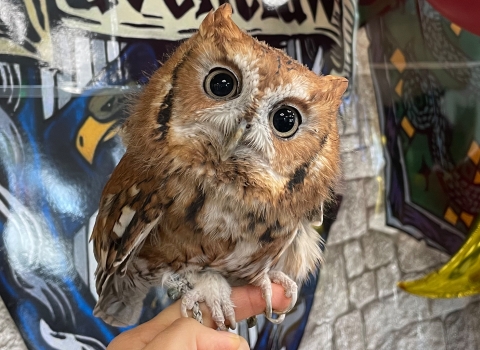Winter storms and cold weather bring our favorite snowy views, recreational sports and winter wildlife-viewing, but they can also bring power outages, travel delays and dangerous conditions. While we’re quick to blame the wind, snow and ice, did you know that storms aren’t the only cause of power outages? Sometimes, wildlife can be to blame, including our nation’s iconic symbol — the bald eagle!
That’s right! Because of their rise in numbers, eagles are an increasingly common threat to our nation’s power lines, cell towers and transmission towers, occasionally interfering with winter heating and putting a frigid hold on typical household tasks. Thankfully, power companies like Pepco Holdings are finding new ways to work with wildlife, prevent power outages and maintain safe infrastructure for both people and wildlife.
A population surge
Bald eagles are an Endangered Species Act success story. In the early 1900s, people still regularly killed and even placed bounties on bald eagles, partly due to perception of eagles as threats to livestock and as competitors to hunters and anglers. After World War II, the pesticide DDT was used to control mosquitoes and washed into our nation’s waterways, eventually finding its way into bald eagles’ bodies and chemically interfering with their ability to produce strong eggshells, often resulting in eggs breaking during incubation. This widespread contamination pushed already-declining bald eagle populations towards extinction. Rachel Carson specifically highlighted the effects of DDT on bald eagles in her monumentally influential 1962 book “Silent Spring,” which helped lead to the bald eagle’s listing under the Endangered Species Preservation Act of 1966 and the banning of DDT in 1972.
Following enactment of the Endangered Species Act of 1973, the Service listed the bald eagle as endangered throughout the lower 48 states. We worked with partners to restore the bird of prey through captive-breeding, reintroduction, law enforcement and nest-site protections.
After decades of concerted effort by many, the Service announced the recovery of our nation’s symbol on June 28, 2007, and removed it from the list of threatened and endangered species. Since the delisting, bald eagle populations have continued to grow at an astonishing rate, with this magnificent bird of prey reclaiming much of its historic range and finding particular success along on our rivers and waterways.
Today, safeguards remain — bald eagles and their nests are still protected under the Migratory Bird Treaty Act and the Bald and Golden Eagle Protection Act year-round.
The current problem
For Pepco Holdings, power company to DC and parts of Maryland, the eagle's resilience is not only a virtue but also a source of concern. These innovative and persistent birds seek novel places to nest in their recovery — including on power poles, transmission towers and other infrastructure. Eagle nests range from four to six feet across and two to four feet tall and weigh up to a ton. They can create a massive safety issue for the eagles and people! Untidy nests, dangling branches, and even eagle excrement — colorfully named streamers — can damage lines and towers.
On a chilly February morning in 2021, a high voltage transmission line along the Potomac River in Maryland experienced an impact that could have led to a power outage if not for the substation breakers operating quickly to prevent an interruption in power delivery to customers. When utility crews investigated the source of the impact, they discovered a sprawling and, to the judgmental human eye, messy bald eagle nest spanning the middle of a Pepco transmission tower.
Investigators guessed that a stick from this bristling nest had slipped onto the conductor below, burned, and then fallen free, causing the short-lived outage. The nest alone constituted a challenge, but what truly complicated matters was what was in the nest: a dutiful adult eagle incubating its precious egg. Immediate action was needed to avoid more serious outages, yet the eagles warranted their own protection.
A bright idea
Thankfully, through the power of partnerships, Pepco Holdings is developing creative ways to protect breeding eagles and its energy customers during the cold winter season. The company’s Avian Protection Program biologist and its talented team of contractors from EDM International decided to try something new and unique, rather than remove the nest during the critical phase of incubation. Their solution was a conservation win and offers a valuable model of how we can find new ways to work with nature, together.
After securing an Eagle Nest Take permit from the Service’s migratory bird program, Pepco Holdings began the first of its two-stage solution. It went to the nest in March 2021 to trim the most hazardous-looking sticks from the bottom of the structure structure
Something temporarily or permanently constructed, built, or placed; and constructed of natural or manufactured parts including, but not limited to, a building, shed, cabin, porch, bridge, walkway, stair steps, sign, landing, platform, dock, rack, fence, telecommunication device, antennae, fish cleaning table, satellite dish/mount, or well head.
Learn more about structure . Pepco Holdings and the Service anticipated correctly that this work would flush the adult eagle off its egg. Eagle eggs, like your average energy customer, need a consistent supply of heat during winter. Even a brief absence from mom and dad can spell catastrophe for an egg. Pepco Holdings was prepared though. Placing a specially designed mobile incubator over the egg during the work, Pepco Holdings successfully kept the egg at a safe temperature and humidity. The crew then left the area as quickly as possible.
Then came the waiting. Ultimately, after weeks of close monitoring, it became clear that the first stage was a success: a young chick reared its head and, after several weeks of parental care, flew from the nest.
In the second stage, Pepco Holdings and engineering experts from AUI Power designed a nest-containment structure that would protect the nest and prevent future outages, a clever advancement on past nest-platform and tower-retrofitting designs. The structure reinforced the nest, making it stronger in the face of harsh winter storms, while also shielding the tower infrastructure from damaging sticks and streamers. This solution is cheaper than trying to relocate the nest and potentially safer than removing the nest, which might encourage the birds to simply select a new tower, recreating the situation.
“Pepco Holdings was presented with a uniquely challenging situation and, in collaboration with EDM International, used its expertise and creativity to find a solution that protected its customers and the eagles, all while responsibly working within our rules and regulations,” explained Thomas Wittig, the Service’s Northeast eagle coordinator. “Collaborating with Pepco Holdings on this issue was a positive reminder of the amazing things we can achieve when working towards common goals.”
With bald eagle breeding populations continuing to grow nearly 10% annually over many areas of the U.S., these solutions are needed more than ever. Pepco Holdings nest containment strategy will serve as a valuable nest management tool and a collaborative solution that warms our hearts no matter the season.






